Here are the best things to do in Hakodate, because no trip to Hokkaido would be complete without a visit to this historic port city!
If you’re planning to travel across Hokkaido, Japan’s northernmost island, you’ll probably kick off your trip in Hakodate. This port city is the first stop for anyone coming up by train, so it only makes sense to get off here before continuing on to Sapporo. At least, that’s how we planned our itinerary!

Hakodate proved to have everything we expected from a port city: a beautiful harbour with historic buildings, a morning market serving fresh seafood, and a fishery museum where we got to experience what it would be like to be fishermen at high sea!
During our trip to Hakodate, we also rode the ropeway up Mount Hakodate for panoramic views, we visited the star-shaped Fort Goryokaku, and sampled some of the local cuisine – namely, Hakodate salt ramen!
This is our list of the best things to do in Hakodate, Japan to help you plan the most epic trip!
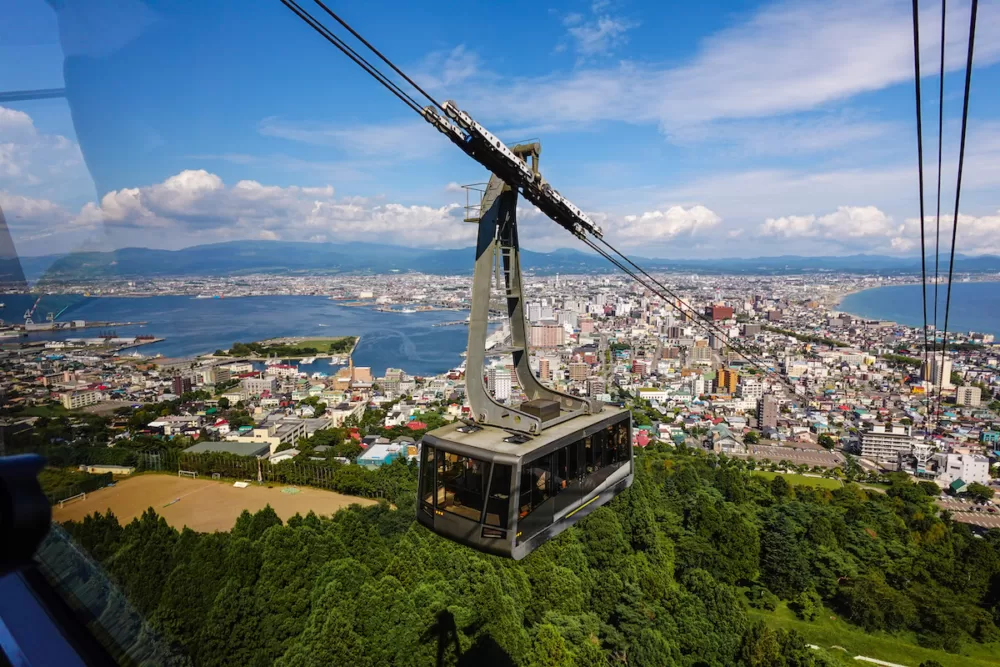
How to get to Hakodate
Getting from Tokyo to Hakodate
Take the Tohoku Shinkansen from Tokyo Station to Shin-Hakodate-Hokuto. This is a 3-hour and 23-minute journey. At Shin-Hakodate-Hokuto Station Train, transfer onto the Hakodate Line to Hakodate Station.
Getting from Sapporo to Hakodate
At Sapporo Station, catch the Hokuto Limited Express to Hakodate. It’s a 3-hour and 46-minute train ride to Hakodate Station.
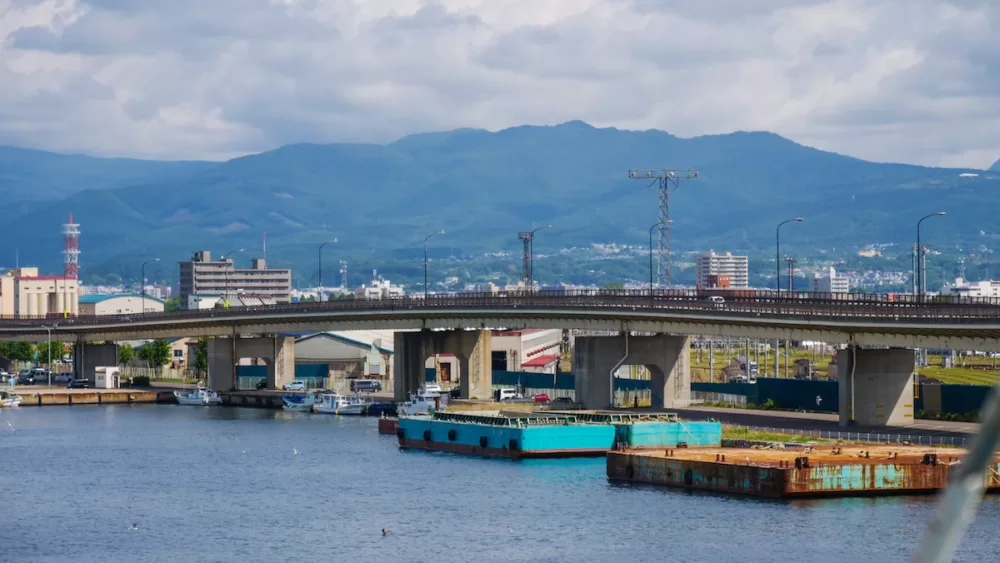
Hakodate Travel Guide
Hakodate Morning Market
If you find yourself in Hakodate, one experience that you absolutely cannot miss is a visit to the legendary Hakodate Morning Market. For over six decades, this market has stood as a testament to the city’s rich fishing heritage and it’s a vibrant hub that draws tourists and locals alike.
Spread across four city blocks, just a two minute walk from JR Hakodate Train Station, the market comes alive daily from the wee hours of the morning. Its official hours are from 5:00 am (shifting to 6:00 am from January to April ) until noon, but don’t be surprised to find it bustling well into the afternoon.
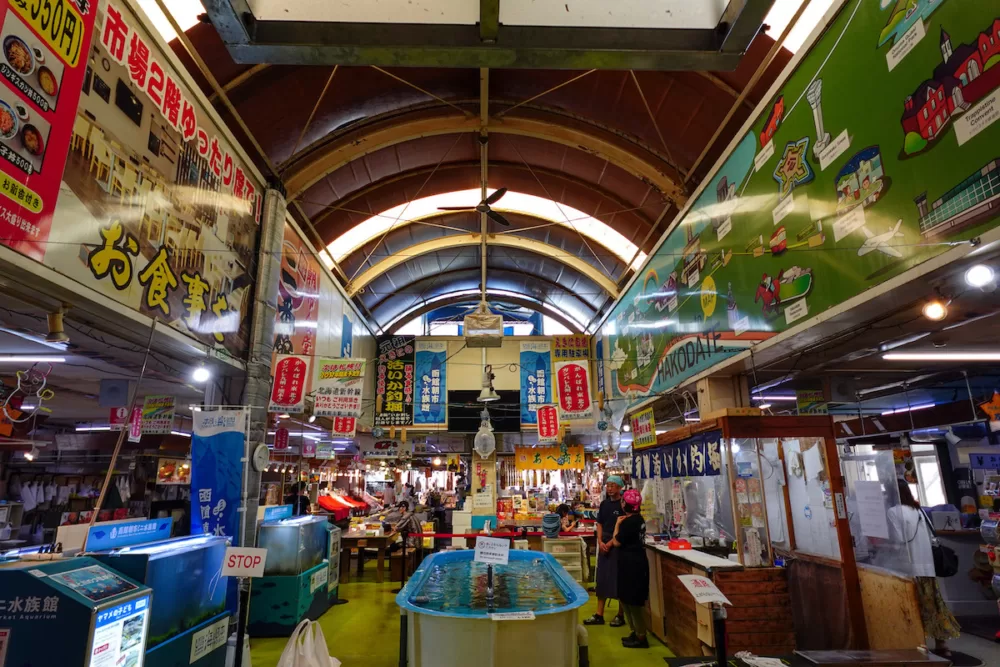
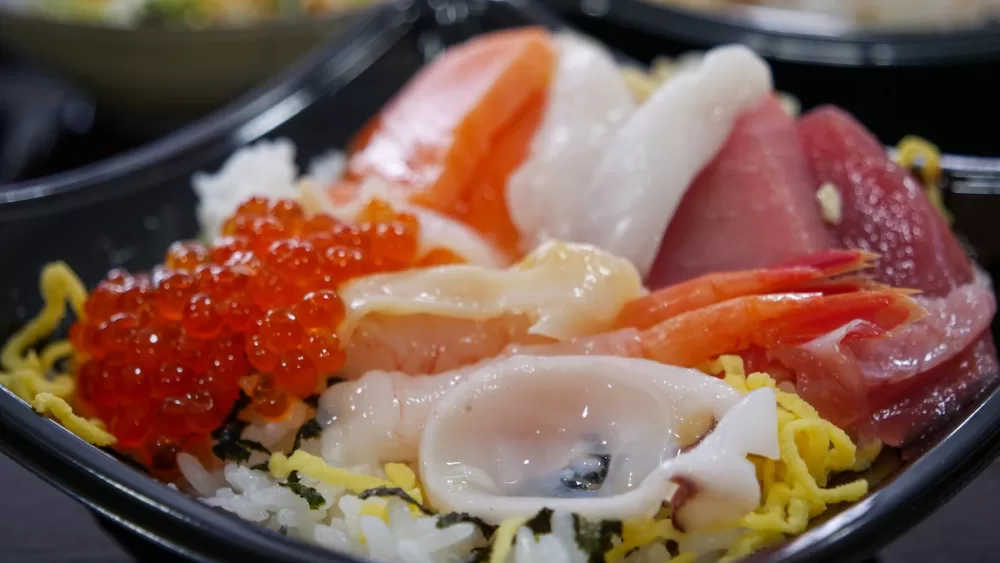
With approximately 250 stalls, the market offers an array of the freshest seafood and plenty of restaurants where you can enjoy it too.
For the quintessential Hakodate experience, I recommend getting up early (you’ll probably be jetlagged anyway!) and skipping the hotel breakfast in favour of a meal at the market.
The thing to order here is kaisendon, a bowl of rice topped with fresh seafood, which depending on the season can include shrimp, crab, tuna, salmon roe, or sea urchin.
We got the kaisendon set which also came with a bowl of soba noodles, a side salad and fried chicken. It was quite a bit of food and a great way to start the day, if you ask me!
Museum Ship Mashu Maru
Nestled in the Port of Hakodate, you’ll find the Mashu Maru anchored as a reminder of a bygone era in Japanese transportation.
This former railway ferry was used to bridge the waters between Hokkaido (the northernmost island) and Honshu (the main island) until 1988.
However, once the Seikan Tunnel was built (we’re talking about a 53-kilometre undersea tunnel that was a feat of engineering!), there was no longer a need for the ferry to cross the Tsugaru Strait.
The Mashu Maru’s final voyage was on March 13, 1988. It is currently docked at the historic No. 2 quay, the very location from which it once embarked on its regular journeys.
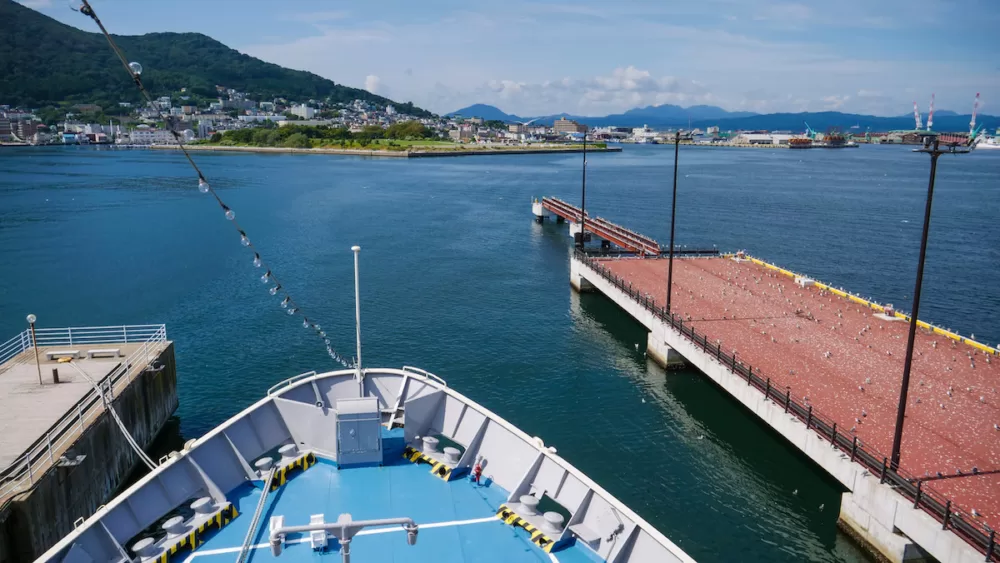
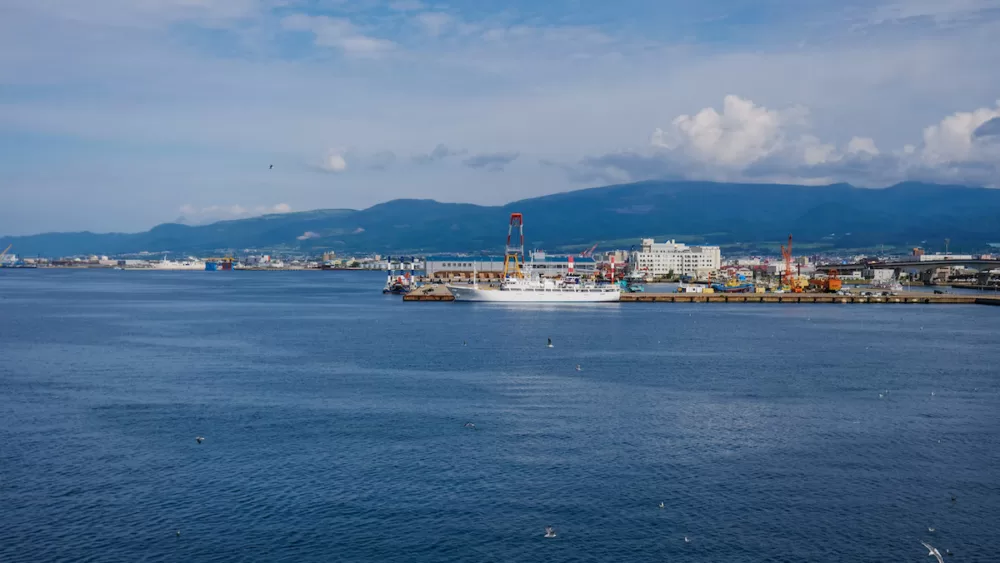
The Mashu Maru, which began its service in 1965, has been meticulously preserved and transformed into a museum. The ship, which has been anchored permanently, offers an authentic glimpse into the life and operations of a mid-20th-century ferry, and from the moment you step aboard, you’re transported back in time.
As you wander through the museum, you’ll discover display panels and models detailing the inner workings of the Seikan ferries, and you can also explore the ship’s bridge and radio communications room. Plus, we quite enjoyed the views of the harbour from the ship!
The Mashu Maru is open from 8:30 am to 6:00 pm (closing at 5:00 pm in winter) and has an admission of ¥500.
Whether you’re a maritime enthusiast or simply curious about the evolution of travel in Japan, the Mashu Maru is a cool spot to visit in the Hakodate Port area.
Kanemori Red Brick Warehouse
The Kanemori Red Brick Warehouses are a historical landmark along Hakodate’s waterfront. Originally established during the Meiji era as a trading post, they played a pivotal role in Hakodate’s development as a key port city.
Today, these distinctive red-brick buildings have been repurposed into a bustling commercial complex and entertainment centre.
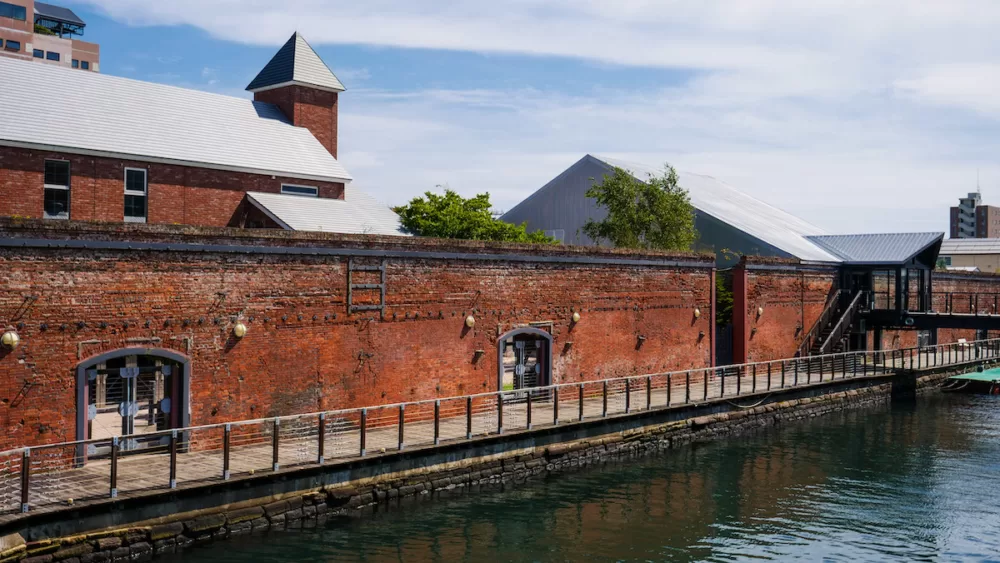
Inside the warehouses, you’ll find an array of shops, boutiques, and galleries, each offering a unique selection of goods ranging from traditional Japanese crafts to modern fashion.
For food enthusiasts, the Kanemori Red Brick Warehouse is also dotted with cafes and restaurants serving everything from local Hokkaido delicacies to international cuisine.
To be honest, my favourite part about visiting the Kanemori Red Brick Warehouse was the architecture. These are really cool buildings with exposed beams, wooden ceilings and industrial lighting. It made the history of this place feel a bit more palpable.
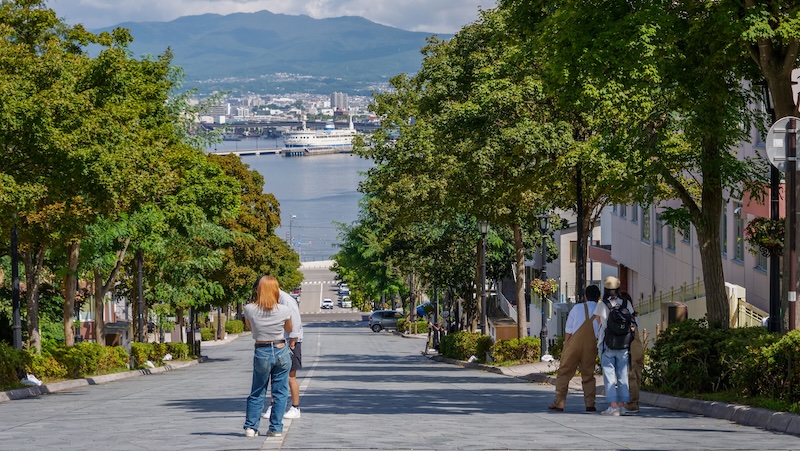
Hachiman Zaka Slope
Hachiman Zaka Slope is a famous street in Hakodate thanks to its steep slope and beautiful views.
Named after the Hakodate Hachiman Shrine, which was originally located nearby, this stone-paved street is lined with rows of trees and boasts views of Hakodate Bay area and the Mashu Maru in the distance.
Among the 19 sloping streets in Hakodate, descending from Mount Hakodate to Hakodate Bay, this one is considered the most beautiful. It’s especially nice at sunset when the city and bay are washed in a soft glow.
On either side of the road, you’ll find stairs or you can take the steep sidewalk. At the top, everyone likes to take photos in the middle of the road, so watch out for traffic.
We found it to be quite the climb (maybe because it was a really hot and humid day!), but we needed to get to the top anyway in order to visit our next attraction!
Motomachi District & Churches
Next, we explored the Motomachi District, which is situated at the foot of Mount Hakodate. This is a neighbourhood where east meets west.
When Hakodate became one of the first ports in Japan to welcome foreign trade, this brought ideas and influence from the west, which can be seen in the city’s architecture.
Some of the main attractions in the Motomachi District are the churches.
- Hakodate Russian Orthodox Church: This church was initially founded in 1858 by the Russian Consulate. However, the current structure was built in 1916 after a major fire. The Hakodate Orthodox Church is known for its distinctive green onion domes and it has a nice garden you can walk around.
- Motomachi Roman Catholic Church: Built in 1859 as a temporary cathedral, this church had to be rebuilt again in 1923 after two major fires. Inside, you’ll find an altar that was gifted by Pope Benedict XV.
- Hakodate St. John Church: This is an Anglican Church that was founded by an English priest who visited Hakodate in 1874. It has an interesting cross-shaped roof.
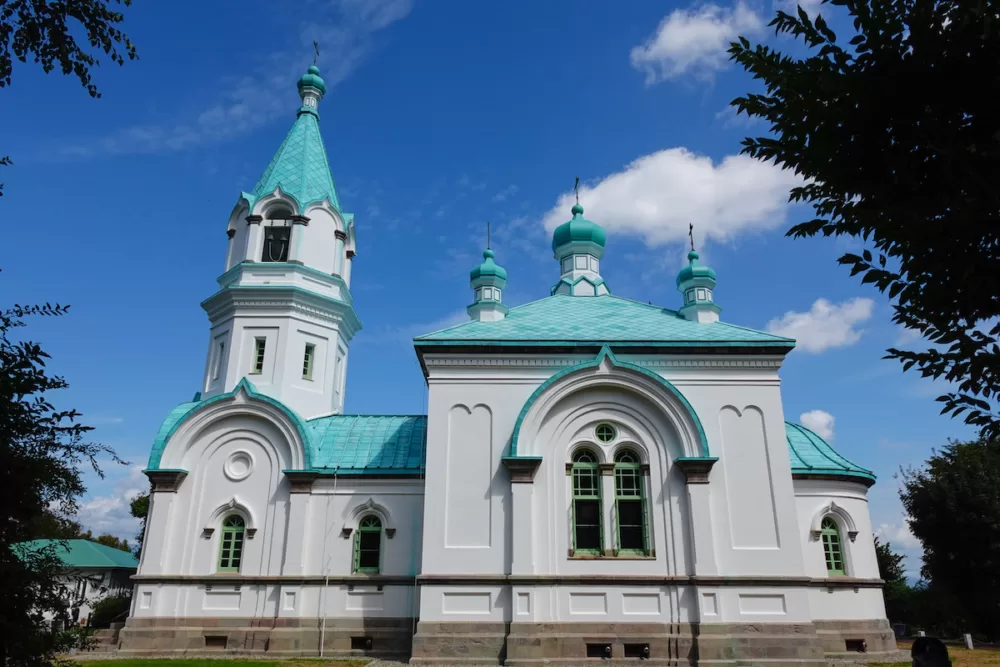
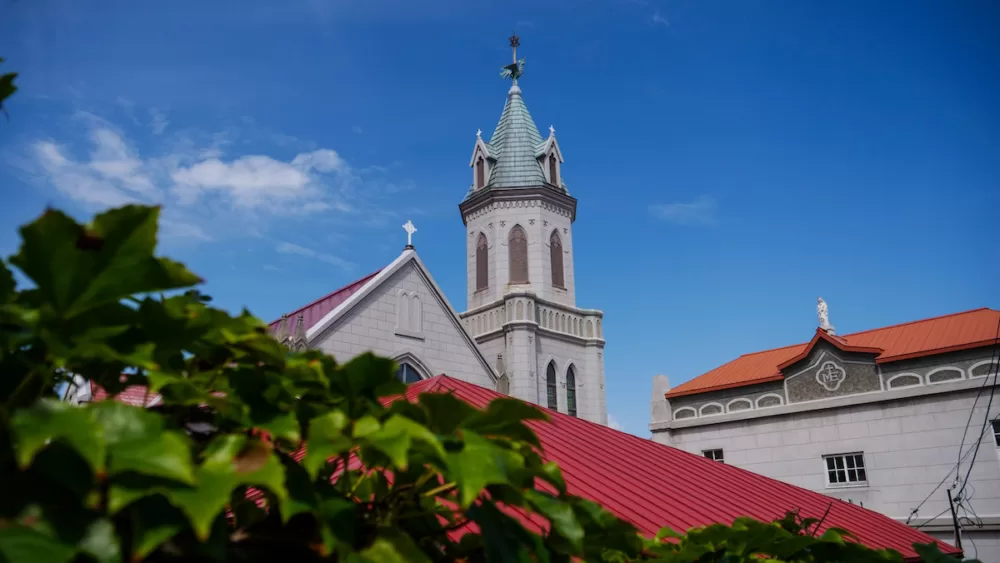
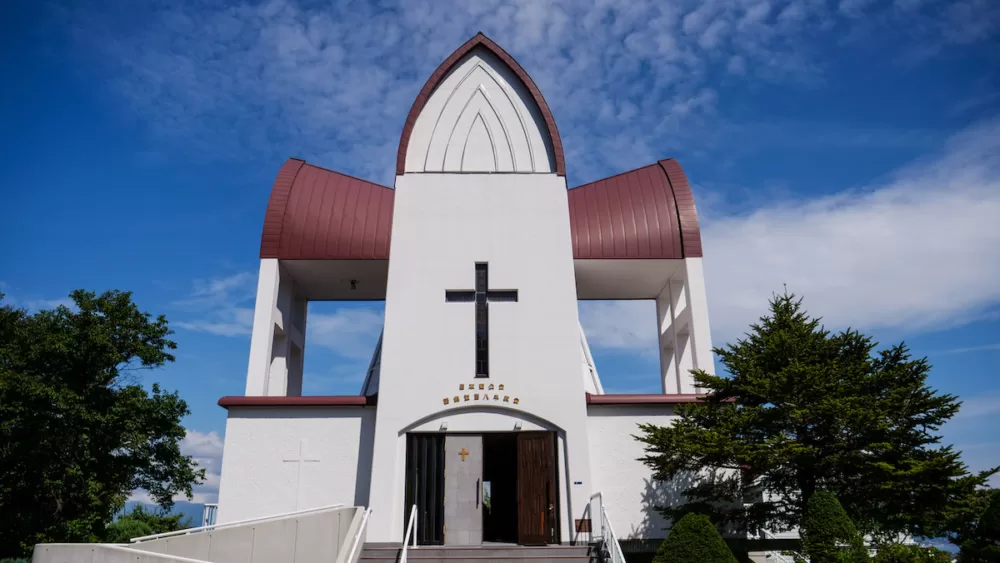
Mt. Hakodate Ropeway
The Mount Hakodate Ropeway is an aerial lift that transports passengers up to Mount Hakodate, an inactive volcanic mountain that stands 334 meters high.
The gondola can carry up to 125 people at a time and it’s a 3-minute journey to the top.
You can walk up or you can drive up, but riding the ropeway is the best way to enjoy the panoramic views of the city, the port and the beaches.
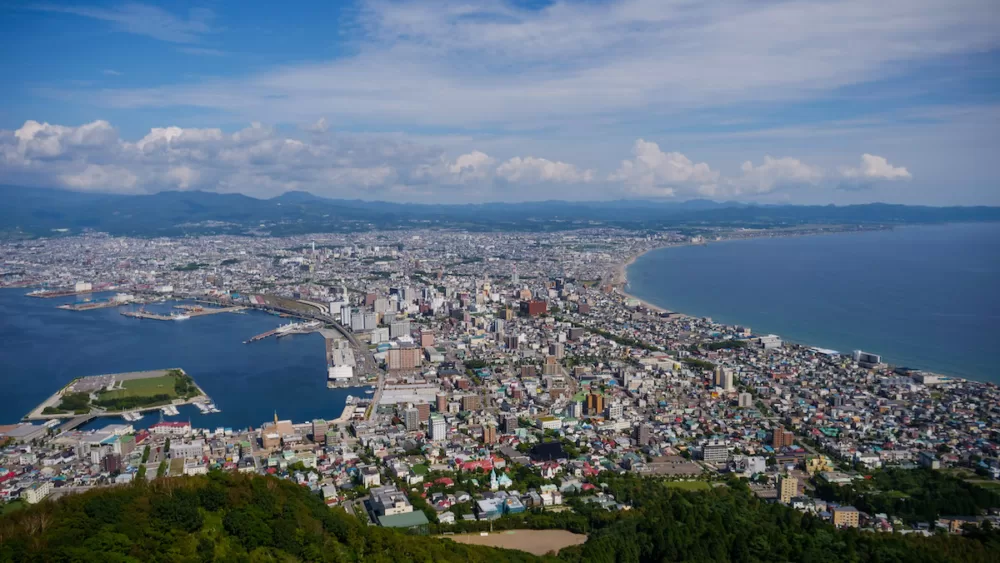
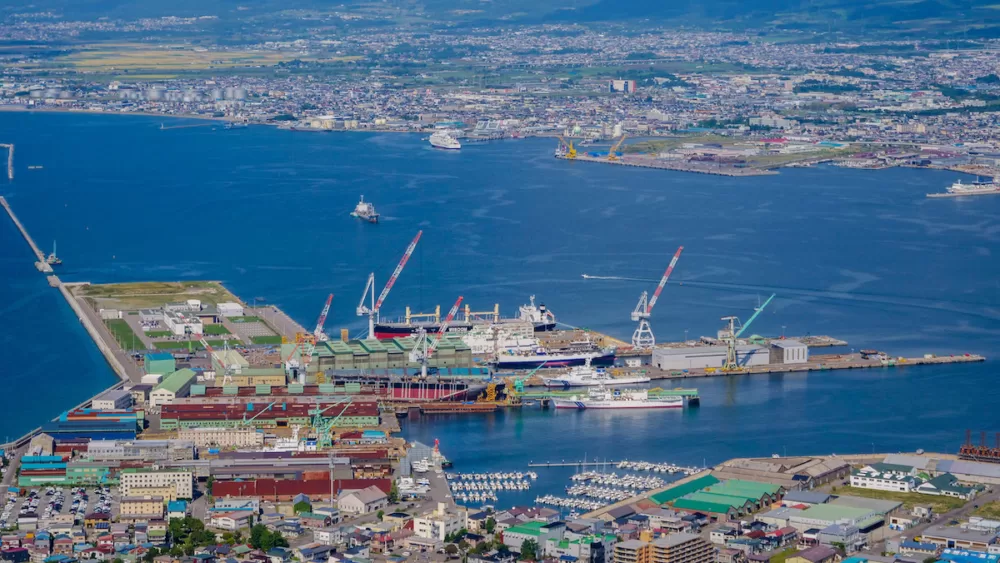
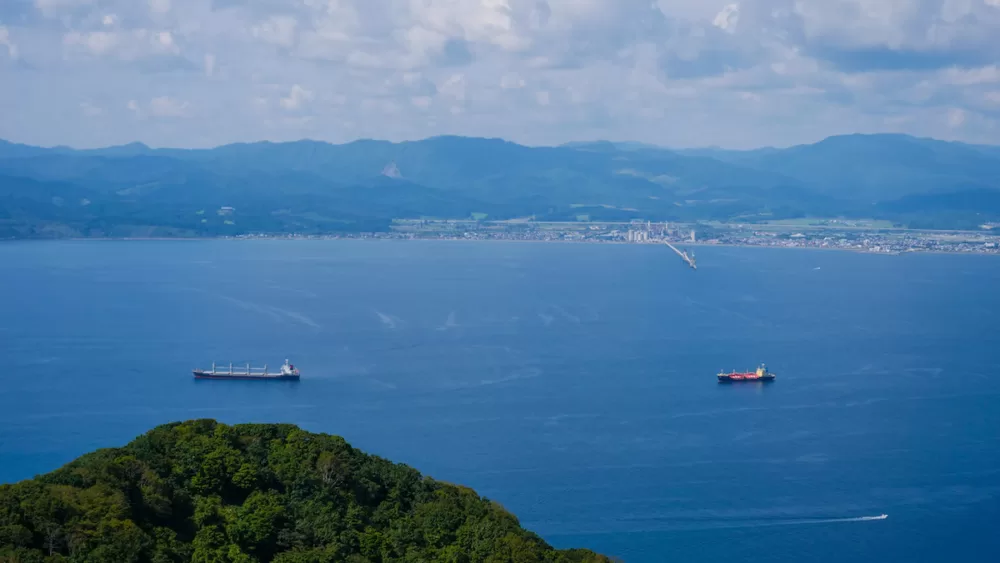
We bought the round-trip tickets for ¥1,800, however, you could pay ¥1,200 one way to go up and then walk back down.
Also, we visited in the daytime, but this is a popular spot for the best Hakodate night view.
Old Public Hall of Hakodate Ward
The Old Public Hall of Hakodate is an important historic building in the city. This is where members of the Imperial family stayed when they visited Hakodate.
The construction you see today was completed in 1910 to replace the previous town hall which burned down in the Great Fire of 1907.
What’s interesting about Hakodate is that it was one of the first ports to open to foreign trade, and this means it received some foreign influence which can be seen in the Western-style architecture. The building is painted a soft blue colour with bright yellow accents.
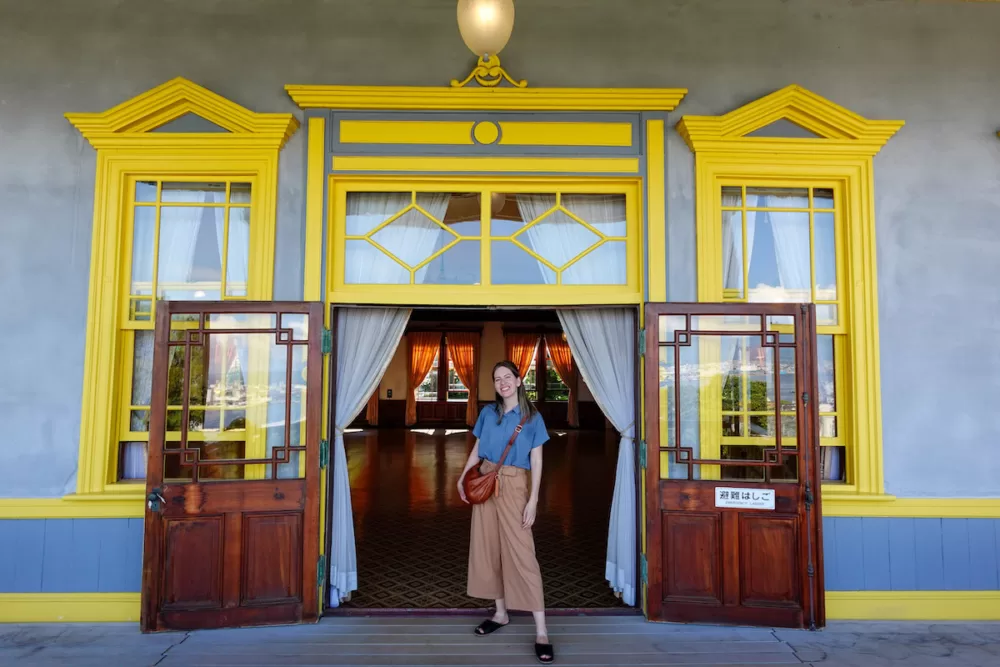
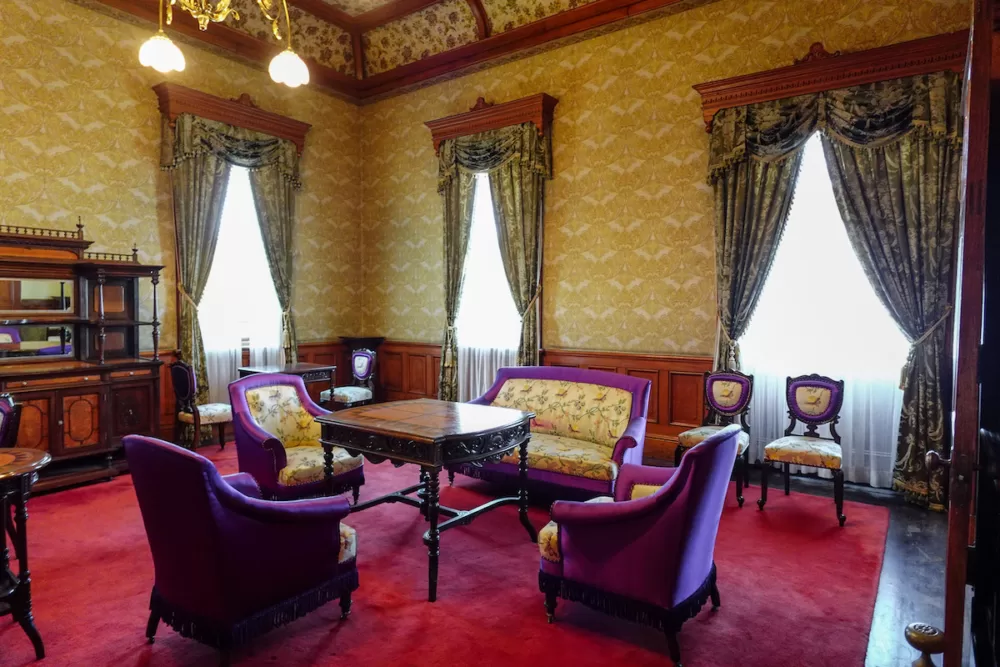
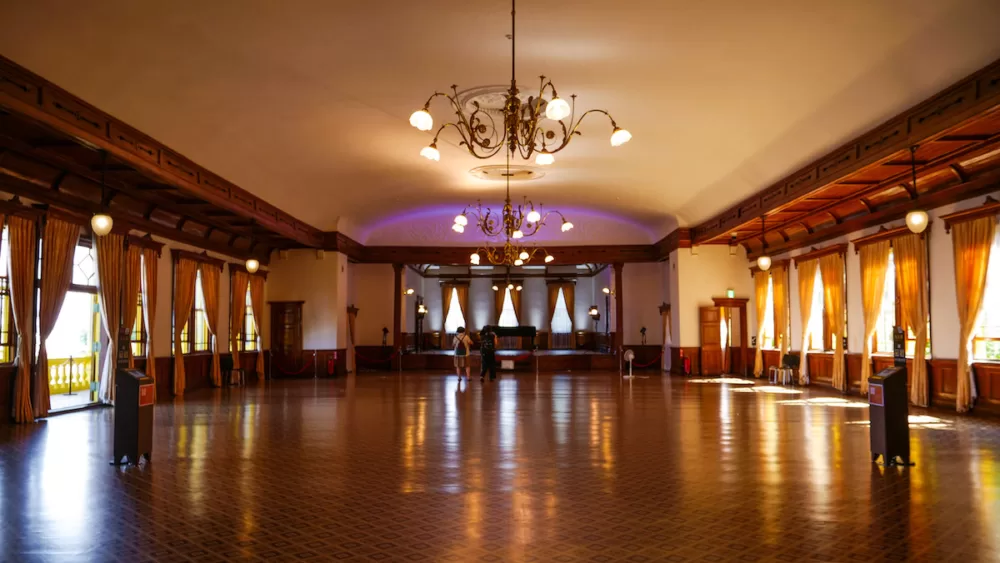
The hall underwent extensive conservation and repair work in 2021, and it’s still used today to host concerts and other events in the Grand Hall.
Visitors can also dress up in costume like lords and ladies and have a professional photoshoot done, however, we opted to just explore the building.
Motomachi Park
Motomachi Park is located at the foot of Mt. Hakodate and it’s a site of significant historical importance in Hakodate.
Before the Muromachi Era (1336–1573), the area where the park now stands was the location of a building named ‘Hakodate,’ from which the city derives its name – ‘hako’ meaning ‘box’ and ‘date’ meaning ‘building’.
Over the centuries, it has been the site of the Hakodate Hachiman Shrine, the Hakodate magistrate’s office during the late Edo period, and the former Hokkaido government office Hakodate branch. The park has continually served as a centre of politics in Hokkaido.
Today, it is surrounded by many famous and historical buildings, including the former Public Hall of Hakodate Ward and the former British Consulate.
It also offers beautiful views of Hakodate Bay and serves as a peaceful resting spot for visitors with plenty of large trees and shade.
Walking through this park is a nice route back down to the waterfront and there are lots of cool sculptures to enjoy along the way.
Hakodate City Museum of Northern Peoples
Since we had quite a bit of rain during our trip to Hakodate, we visited several museums, one of them being the Hakodate City Museum of Northern Peoples.
This museum focuses on the Ainu, Uilta and Aleut who inhabited the areas of Hokkaido in Northern Japan, the coastal regions around the Okhotsk Sea in Russia, and the Aleutian Islands.
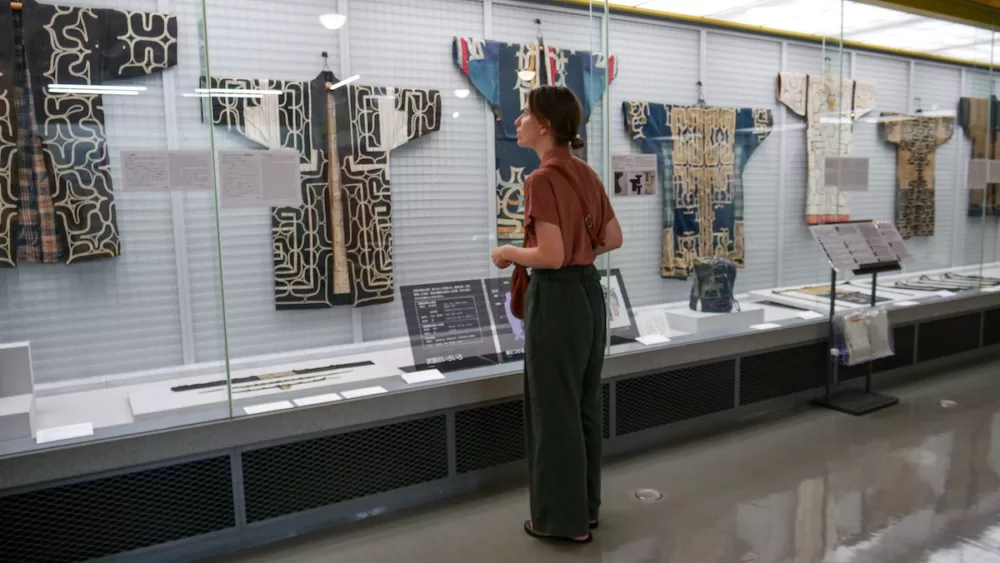
The northern peoples lived in extremely cold and harsh climates, and the museum showcases the clothes they would have needed to withstand the environment. You can also see the tools they would have used for fishing and hunting. Plus, there are descriptions of the diets they would have eaten, featuring lots of fish, bear and kelp!
The Museum of Northern Peoples is housed in the former Bank of Japan building that dates from 1926.
We really enjoyed our visit and would recommend visiting not just as a rainy day activity, but to learn more about the Northern Peoples.
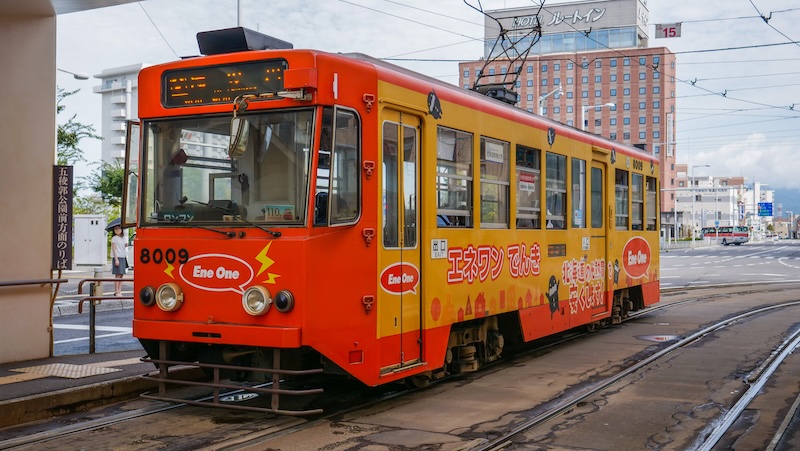
Hakodate Tram
One fun way to move around Hakodate is by riding the vintage trams or streetcars!
There are only two tram lines in the city, and they follow the same route except for the last three stops. Tram 2 runs from Yunokawa to Yachigashira, while Tram 5 runs from Yunokawa to Hakodate-Dokkumae.
These two lines are great for sightseeing as they go past lots of Hakodate’s main tourist attractions. This is a handy guide to Hakodate’s tram system.
Hakodateshi Hokuyo Museum
Because it was a rainy day we were looking for indoor activities, so we decided to visit another museum. Next up, we visited the Hakodateshi Hokuyo Museum, also known as the Hakodate City Northern Pacific Fishery’s Document Museum.
The museum focuses on the connection between Hakodate and the sea emphasizing the North Sea Fishery that once prospered in the area.
This is a quirky little museum where you can see a taxidermied polar bear, a walrus, and loads of sea lions.
However, I would say the highlight was trying their fishing boat simulator. Basically, you walk into a room with a screen that plays waves of the high seas in wintertime, and then the room begins to rock and sway to mimic the stormy waves.
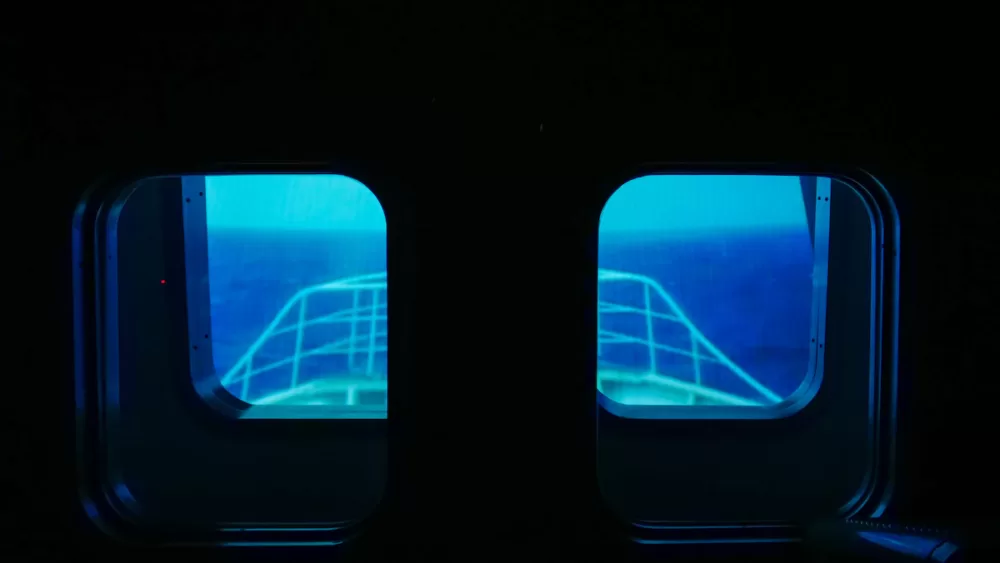
The whole experience only lasts 3 minutes, but it’s enough to make you dizzy and appreciate the work fishermen do because it’s sure not easy!
The admission fee to the museum is very reasonable, at just ¥100, making it an accessible attraction for visitors.
Goryokaku Park and Fort
Goryokaku Park is a historical park renowned for its unique star-shaped fort, which played a significant role in Japan’s history.
This style of fortification was inspired by Western military architecture and was designed to provide better defensive capabilities than traditional castle structures.
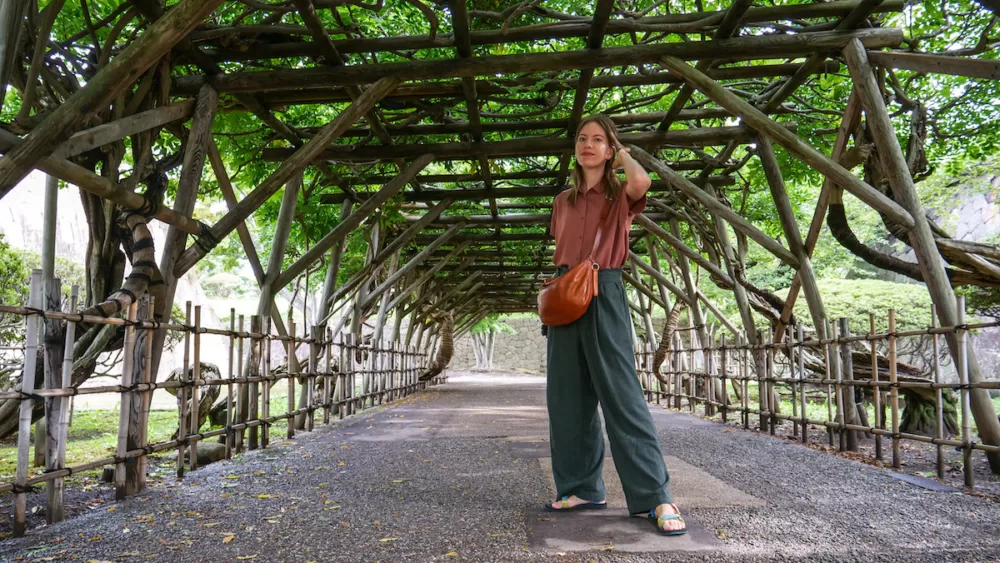
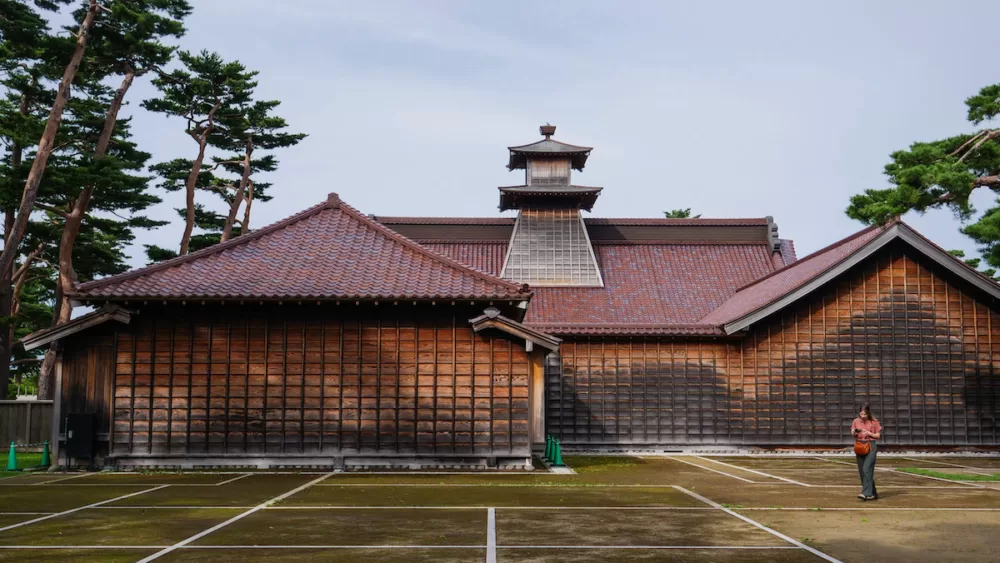
Goryokaku Fort was originally built as part of Japan’s efforts to modernize its defences. Fort Goryokaku was completed in 1866 and it was used as the main headquarters of the short-lived Republic of Ezo – the island of Ezo is what’s today known as the island of Hokkaido.
The Republic of Ezo was the first government to attempt to institute democracy in Japan, though voting was only extended to the samurai caste, and it managed to exist for five months before it was annexed by the newly established Empire of Japan.
Goryokaku Park is a popular spot to see cherry blossoms with the flowers blooming early to mid-May. So if you’re visiting in the springtime and looking to enjoy some hanami (flower viewing) this is a great place to do so!
Visiting the Park and the fort is free, though there is an admission fee for the Hakodate Magistrate Office.
Goryokaku Tower
Goryokaku Tower stands 107 meters tall and is an iconic observation tower located within Goryokaku Park in Hakodate.
The tower offers visitors 360-degree views of Goryokaku Park, the star-shaped Goryokaku Fort, and the surrounding area, making it one of the city’s top tourist attractions.
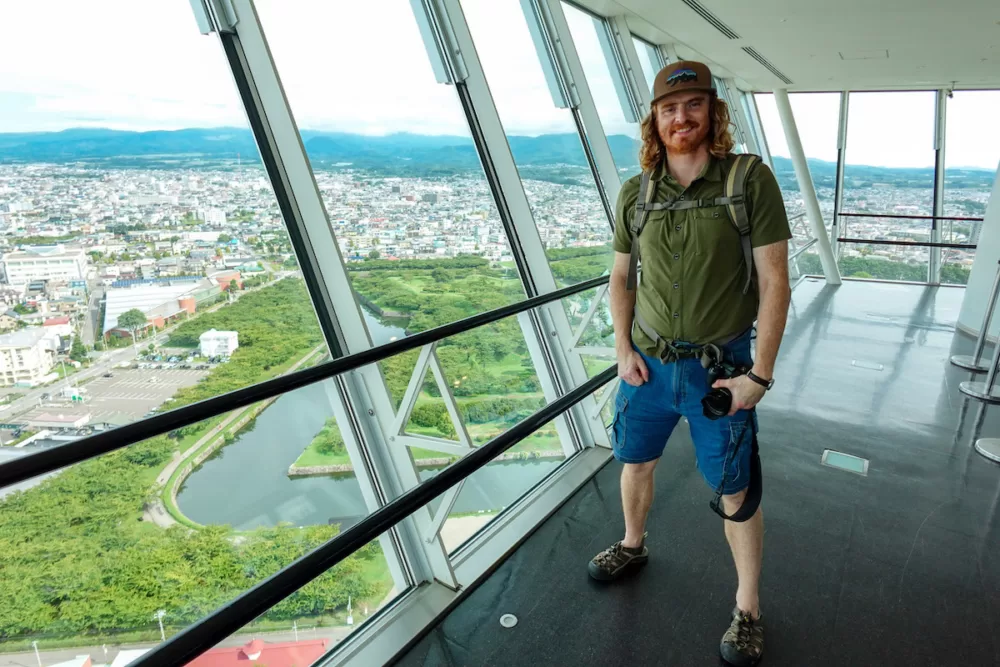
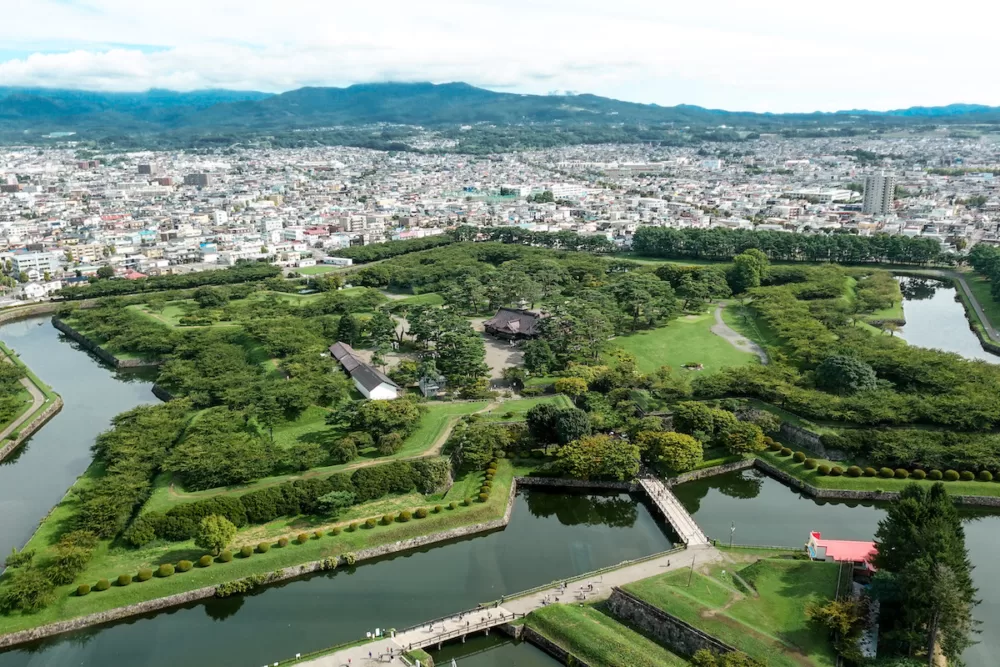
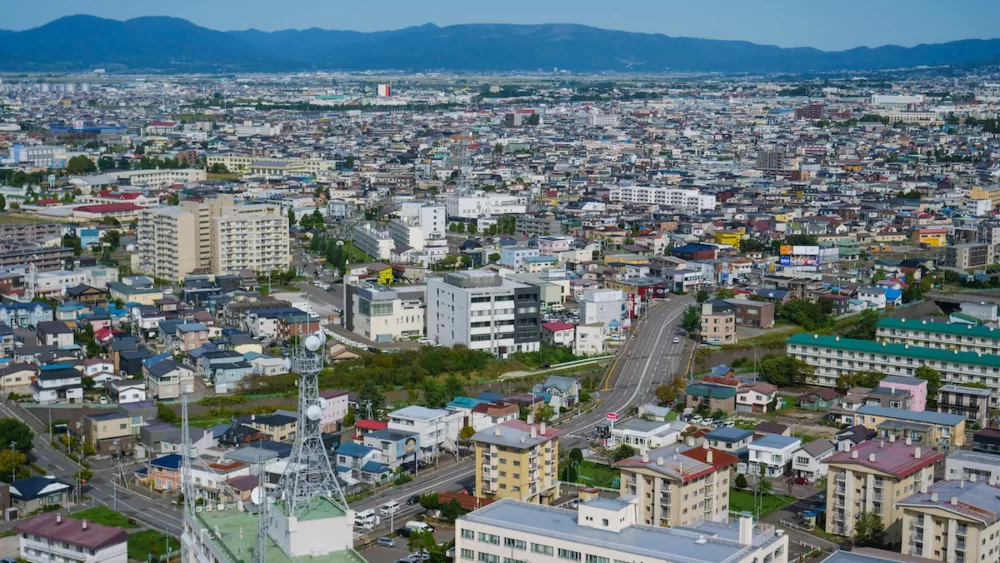
If you’re already at the park, it’s worth going up for a bird’s eye view.
What to eat in Hakodate
Hakodate Salt Ramen
If you only have time to try one local dish in Hakodate, make it the Hakodate Salt Ramen also known as Hakodate Shio Ramen.
This is the culinary specialty of Hakodate and is recognized as one of Hokkaido’s must-try ramens right up there with Sapporo Miso Ramen and Asahikawa Soy Sauce Ramen.
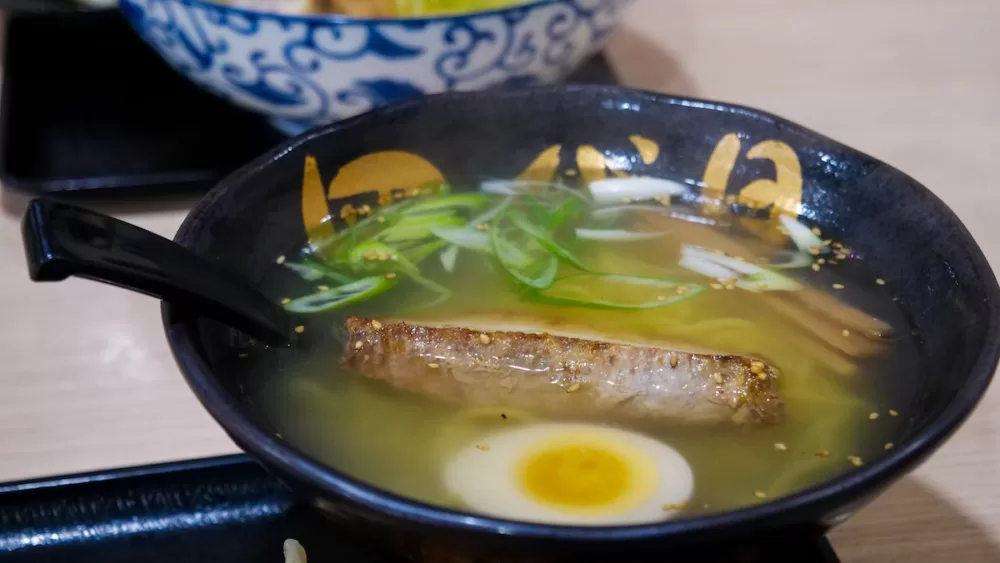
Hakodate Salt Ramen first made its appearance in 1884, making it potentially one of the earliest types of Japanese ramen. The dish features very thin, straight noodles and common toppings include thick slices of roasted pork, scallions and bamboo strips, just to name a few.
The broth is known for its clarity and lightness, especially when compared to the milky broths of other ramen styles. It is less fatty than its cousins from Sapporo and Asahikawa and stays true to its Chinese roots with a clear broth that lacks seafood or seaweed flavouring in the stock.
We ate at a place called Yondaime Ramen, where we ordered from a ticket vending machine. Sam got the Yondaime Salt Ramen with broiled pork, which is the restaurant’s #1 best seller. Meanwhile, I got the plain salt ramen flavour which is made with a clear chicken broth.
It was delightfully warm, flavourful and filling. The perfect meal for a rainy day!
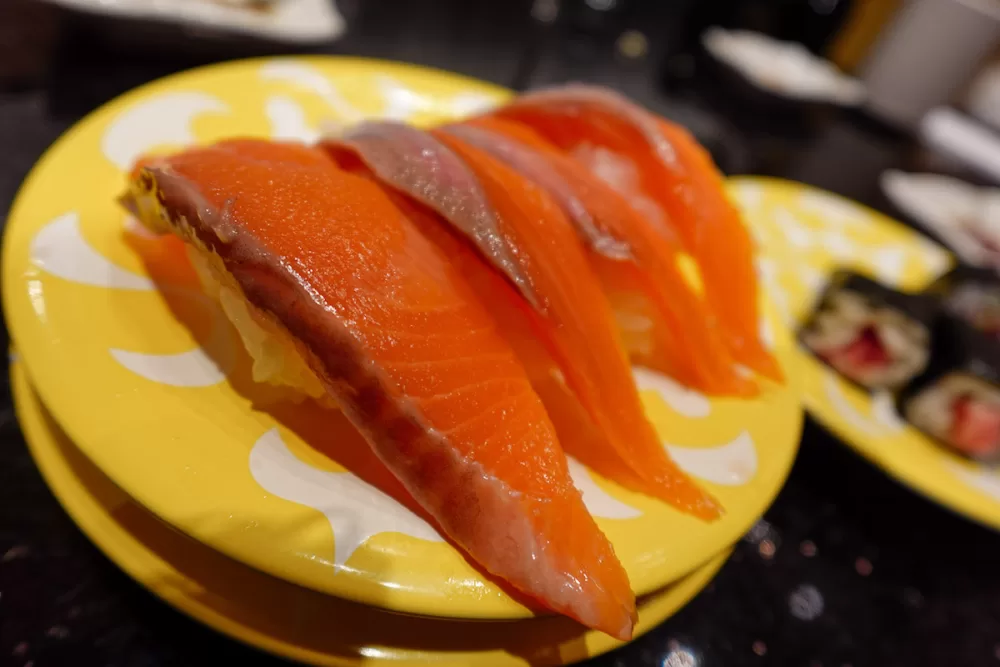
Fresh Seafood
Hakodate is renowned for its fresh and delicious seafood. The city’s location on the coast of the Sea of Japan makes it a prime destination for seafood lovers and there are several types of seafood to try.
- Crab (Kani): Hokkaido, including Hakodate, is known for its high-quality crab. Snow crab (Zuwai-gani) and king crab (Taraba-gani) are the most famous varieties. You can enjoy crab dishes such as kani sashimi, kani nabe (hot pot), or grilled crab legs. Many restaurants in Hakodate offer crab-centric menus, especially during the winter season when crab is in season.
- Sea Urchin (Uni): Hokkaido is a major producer of sea urchin, and you can savour the creamy and sweet uni at seafood markets and sushi restaurants in Hakodate. Uni is often served as sushi, sashimi, or in rice bowls (uni don).
- Scallop (Hotate): Hokkaido is also known for its large and succulent scallops. You can enjoy them grilled, pan-seared, or as sashimi. Grilled scallops with a miso or butter sauce are a popular choice.
- Salmon Roe (Ikura): Ikura, or salmon roe, is a common topping for sushi and rice bowls in Hakodate. The bright orange, slightly salty roe bursts with flavour and is a must-try for seafood enthusiasts.
- Seafood Donburi: Donburi, or rice bowls topped with seafood, are a delicious and filling option. You can find seafood donburi dishes that feature a mix of fresh seafood, often served with a flavorful sauce or marinade.
- Shrimp (Ebi): Shrimp dishes, including tempura, are commonly found in Hakodate’s seafood restaurants. The sweet and tender local shrimp make for a delightful meal.
- Herring (Nishin): Hakodate is known for its marinated herring dishes, often served as nishin sushi or pickled nishin hoba miso, which is herring simmered in a rich miso sauce and served on a magnolia leaf.
- Sushi and Sashimi: Hakodate has a thriving sushi scene, and you can’t visit the city without trying fresh sushi and sashimi made from a variety of seafood. Look for local sushi restaurants or seafood markets for the best options.

Lucky Pierrot
Lucky Pierrot is a renowned hamburger chain exclusive to Hakodate. Established in 1987, this restaurant chain has expanded to 17 different locations within Hakodate.
Each restaurant has its own distinct theme (a good reason to try and visit them all!) including Birds of the World, History of Hamburgers, Audrey Hepburn, artworks by Botticelli, Elvis Presley and more.
The theme of the restaurant we visited was ‘Angels’ with cherubs hanging from the ceiling and lots of angel sculptures and angel paintings.
Lucky Pierrot has won a whole bunch of awards including the first prize for Best Local Burger store in Japan!
That being said, their menu is quite eclectic with hamburgers, Japanese curry and spaghetti all featuring as main dishes, as well as soft serve ice cream and sesame balls on the dessert menu.
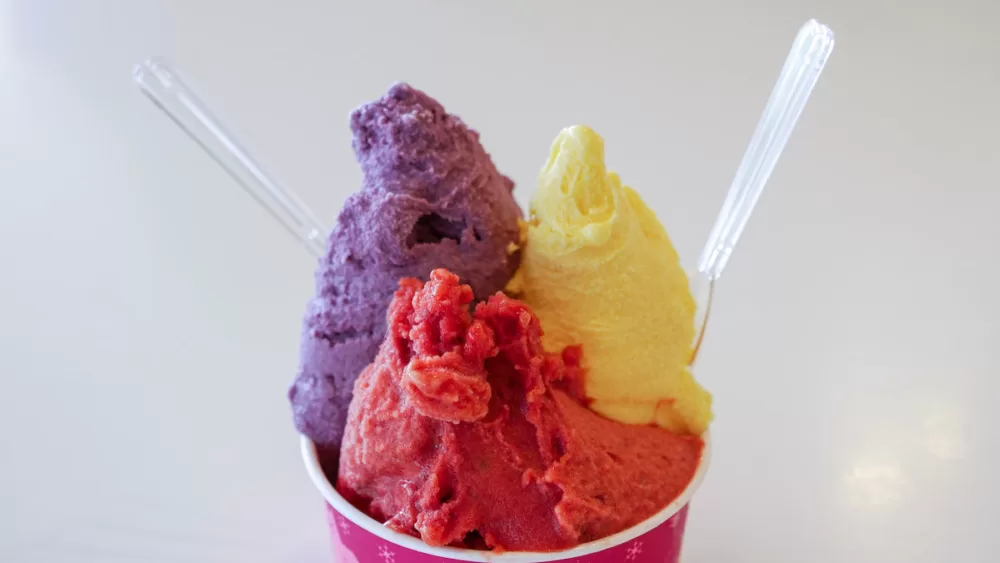
Hokkaido Ice Cream
The island of Hokkaido is responsible for producing over 50% of Japan’s milk. Known for its cool climate and wide pastures, the region has become very famous for its dairy products, especially its ice cream.
For a little something sweet, we went to Milkissimo, an ice cream shop located inside Goryokaku Tower.
Their gelato flavours are made using ingredients unique to Hokkaido and also fruits that are in season. That means their ice cream flavours change throughout the year.
We opted for 3 flavours: pumpkin, purple sweet potato, and haskap berry also known as the honeyberry. They also had flavours like chestnut, matcha and plain milk.
You’ll be able to try lots of strange soft-serve ice cream as you travel across Japan, however, if you can try gelato even better!
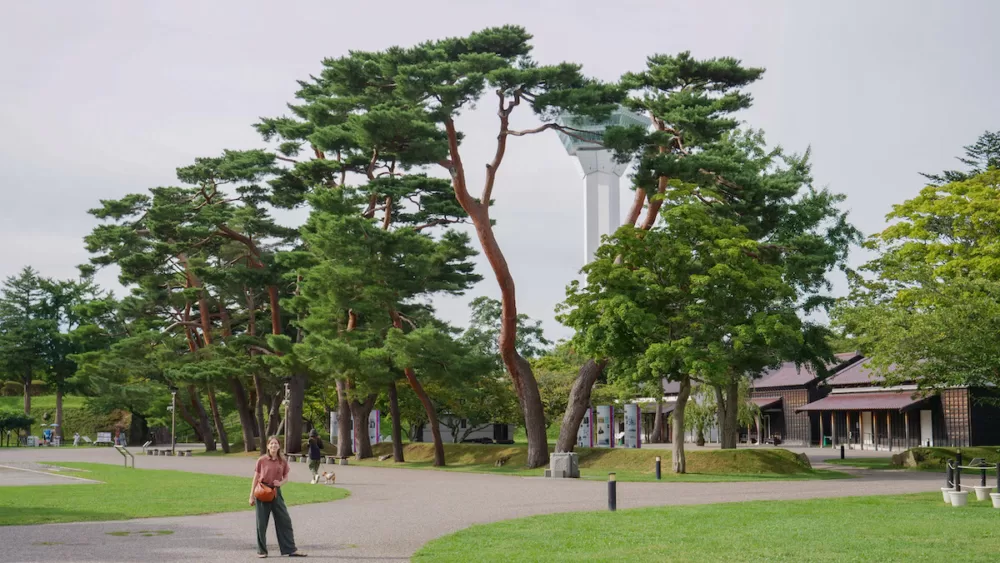
Where to stay in Hakodate
Near Hakodate Station
Staying close to Hakodate Station is ideal for easy access to public transportation. This area is perfect for travellers who plan to explore beyond the city. You’ll find a range of hotels here, from luxury to budget-friendly, ensuring comfort and convenience.
Motomachi
For those interested in the historical aspect of Hakodate, the Motomachi area is a great choice. This district is home to a blend of Western and Japanese-style buildings and offers easy access to major tourist attractions like the Old Public Hall of Hakodate Ward and the Motomachi Roman Catholic Church. The area has charming guesthouses and boutique hotels, providing a more intimate and culturally rich experience.
Goryokaku
If you’re interested in Hakodate’s history, consider staying near the Goryokaku Fort. This area is a bit quieter and offers a mix of modern hotels and traditional ryokans. It’s a great place to experience both the historical and modern sides of Hakodate.
Yunokawa Onsen
For a relaxing stay, choose the Yunokawa Onsen area, known for its hot spring resorts. This area is a bit further from the city centre but offers a tranquil and luxurious experience with its range of onsen hotels. It’s perfect for those looking to unwind and enjoy the therapeutic benefits of the hot springs.
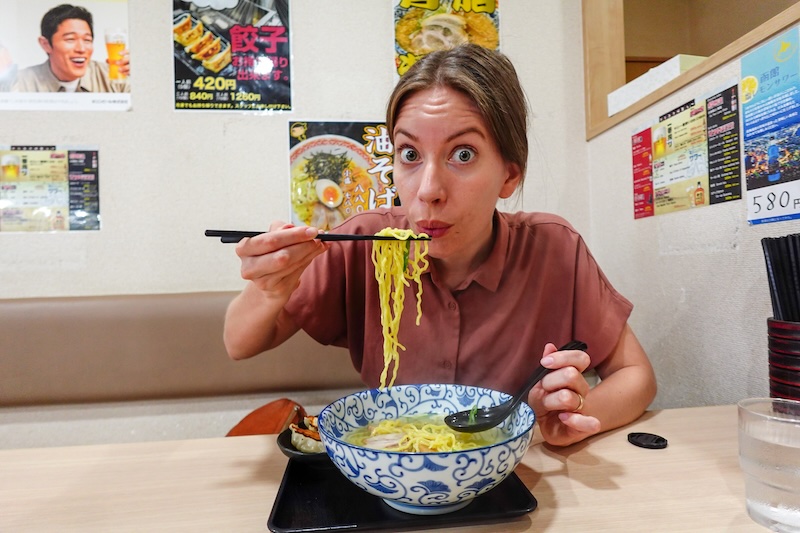
Day Trips from Hakodate: Exploring Beyond the City
- Onuma Quasi-National Park: About 30 minutes by train, this scenic park offers boating, cycling, and walking trails around picturesque lakes dotted with small volcanic islands. Fall colours here are gorgeous!
- Matsumae Castle: Visit Japan’s northernmost castle, famous for its cherry blossoms in spring and dramatic ocean views year-round.
- Esan Onsen: For a super local hot spring experience, travel east along the coast for wild volcanic scenery, rustic baths, and seafood restaurants where you’ll eat what’s caught that morning.
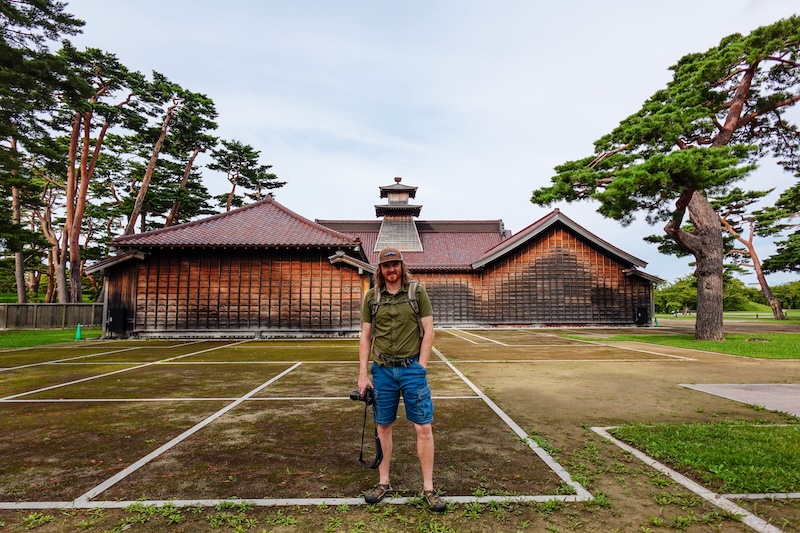
Getting Around Hakodate: Trams, Buses, and Walkable Wonders
One of the things I loved most about Hakodate is how easy it is to get around. The city’s major sights are surprisingly compact, so you can explore a ton by foot, tram, or bike—no rental car needed!
Trams:
If you want to travel like a local (and give your feet a break), hop on one of Hakodate’s two retro tram lines. The trams are colour-coded and easy to navigate, with English signage at major stops. Buy a one-day pass (Ichinichi Josha-ken) at the station or on board for unlimited rides—great value if you’re sightseeing across town. The tram even has stops for Yunokawa Onsen, Goryokaku, and the waterfront.
Buses:
For destinations the trams don’t reach (like Mount Hakodate’s base or the ferry terminal), local buses are frequent and reliable. Google Maps works surprisingly well for Hakodate’s transit, so just plug in your destination and follow the directions.
By Foot or Bicycle:
The Motomachi district, waterfront, and Morning Market are all within walking distance from Hakodate Station. If you’re feeling energetic (or just want to feel the sea breeze), several guesthouses and hotels offer bike rentals—a fun way to explore quieter residential neighbourhoods and discover local bakeries or coffee shops off the tourist path.
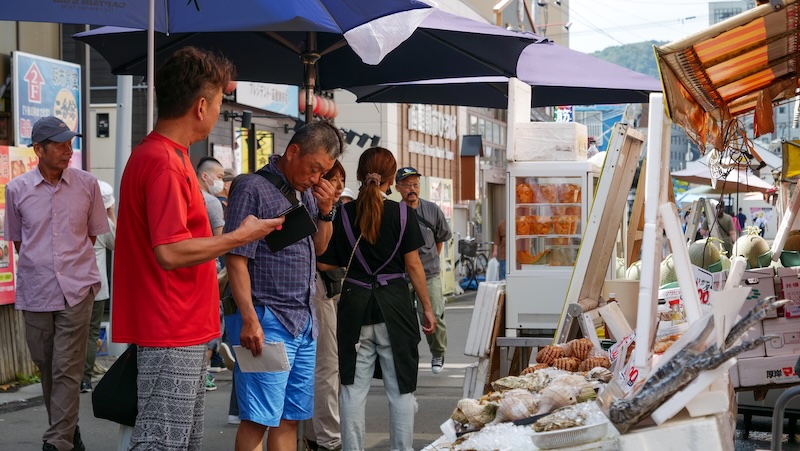
Best Time to Visit Hakodate: Weather, Events & Seasonal Highlights
Hakodate is a true four-season city, and each season brings its own special charm. Here’s what to expect:
Spring (April–May): Hanami Season
- Cherry blossoms in Goryokaku Park are legendary—imagine a star-shaped moat ringed with thousands of trees in full pink bloom! Go early in the morning to enjoy peaceful hanami before the picnic crowds arrive.
- The weather can be chilly and sometimes rainy, so pack a warm jacket and an umbrella.
Summer (June–August): Festive Vibes
- Summers are mild compared to much of Japan, with cool ocean breezes and average highs around 20°C (68°F).
- Enjoy outdoor festivals like the Hakodate Port Festival in early August, which features a massive fireworks display, traditional Yosakoi dancing, and local food stalls galore.
- Early summer is the best time to try squid (ika) fresh from the bay—look for squid fishing boats all lit up at night!
Autumn (September–November): Fall Colours
- The mountains around Hakodate explode in fiery reds and golds; head to Hakodate Park or trek partway up Mount Hakodate for colourful views.
- Seafood is at its best in autumn, especially crabs and salmon.
Winter (December–March): Snowy Scenery & Onsen
- Hakodate gets plenty of snow, turning the city into a winter wonderland. The Motomachi slopes look extra magical dusted in white.
- Warm up at Yunokawa Onsen, where you can even spot Japanese snow monkeys bathing in the hot springs!
- Don’t miss the Hakodate Christmas Fantasy Festival, when the red brick warehouses are lit with festive lights and a floating Christmas tree glows in the bay.
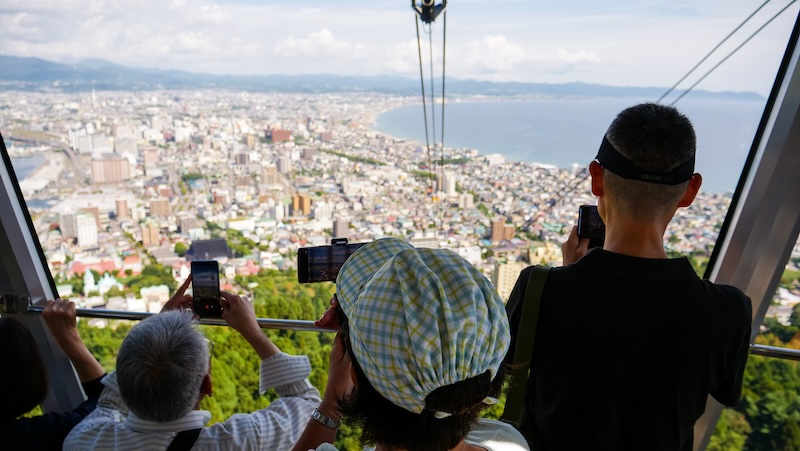
Is Hakodate worth visiting?
Hakodate is well worth a visit for anyone planning a visit to the island of Hokkaido. If you’re arriving in Hokkaido by train, your first stop on the island will be Hakodate so this is a very logical first destination before you continue on to Sapporo and beyond.
We chose to make Hakodate our first stop so there wouldn’t be any backtracking. Plus we had already spent several hours on the train up from Tokyo, so we didn’t feel like adding another 3-and-a-half-hour journey to reach Sapporo.
Aside from logistics, this city is a cool introduction to the island where you can learn about Hakodate’s development from a mere trading post to a key port city.
Hakodate has enough attractions to keep you busy sightseeing for 2-3 full days.
Where to go after Hakodate
Noboribetsu Onsen
Noboribetsu Onsen is a hot spring resort town situated on the southwestern side of Hokkaido. This area is known for its volcanic landscapes punctuated by steam vents, bubbling lagoons and powerful geysers.
Some of the highlights include hiking through Hell Valley locally known as Jigokudani, dipping your feet in the Oyunuma River Natural Footbath, visiting Enamdo Temple which houses an animatronic puppet, and enjoying spicy ramen noodles! You can get some ideas of more things to do in Noboribetsu Onsen here.
Of course, the accommodations of choice when staying in an onsen town is a ryokan and this town has plenty to choose from.
Sapporo
Sapporo is the largest city on the northern Japanese island of Hokkaido and serves as the capital city of Hokkaido Prefecture.
Some experiences not to miss when visiting Sapporo include going up Sapporo TV Tower for panoramic city views, visiting Ramen Alley for a bowl of miso ramen with corn and butter, and enjoying a beer tasting at the Sapporo Beer Museum.
This city is best known as a winter destination thanks to Sapporo Snow Festival, however, it’s a destination that can be enjoyed year-round.
Otaru
Otaru is a picturesque city located on the western coast of Hokkaido facing the Sea of Japan. It’s located approximately 25 kilometres northwest of Sapporo, so it’s a very logical place to visit either on a day trip or for a few days.
This charming port city is known for its well-preserved historical buildings, scenic canals, and a strong connection to its maritime heritage.
Some of the highlights include a boat ride through the Canal District which is lined with historic stone warehouses, exploring the city’s glassmaking industry through its shops and glassmaking studios, and visiting a restaurant that is still illuminated by gas lamps and feels like a step back in time.
